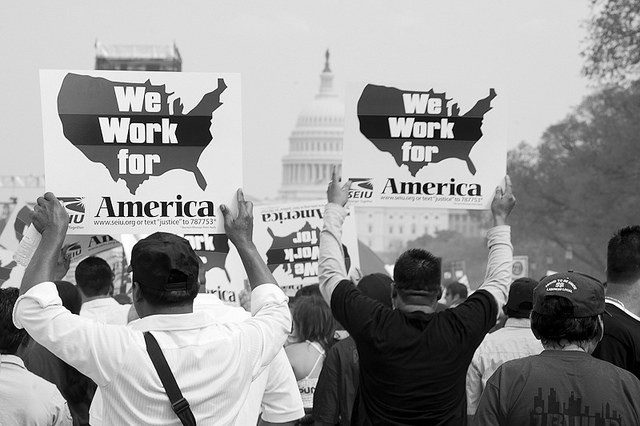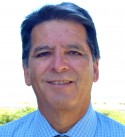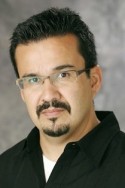
Congress appears on the verge of passing some version of a comprehensive immigration reform bill likely to include a provision legalizing millions of unauthorized immigrants for the first time since landmark immigration reform did the same in the mid 1980s. Back then, backers of that legislative effort assured the nation that this was a one-time measure, but here we are again, much to the frustration of both immigration critics and immigration supporters (who don’t want immigrants to have to come without documentation, with all the hardship that entails). So, in advance of “What would Immigration Reform Mean for Los Angeles?”, a Zócalo/Azteca America Event in partnership with the California Community Foundation, we asked a number of experts, “How can immigration reform best avoid attracting another wave of undocumented immigrants to Los Angeles?”

California and Los Angeles undoubtedly have much at stake in the efforts to reform our flawed immigration system. One of the most important considerations is how we handle unauthorized immigration. The 1986 Immigration Reform and Control Act (IRCA), which offered amnesty to undocumented workers at the time, addressed but did not solve this issue—as the presence today of 2.6 million unauthorized immigrants in California (nearly one million residing in Los Angeles alone) makes clear. What lessons can we learn from IRCA and what are the key reforms necessary to manage unauthorized immigration?
One thing IRCA got right was granting a pathway to legal status for the unauthorized immigrant population of the time. Policymakers designing the reform also correctly recognized that jobs are the primary draw for most unauthorized immigrants, and hence instituted employer sanctions for hiring unauthorized immigrant workers. However, the sanctions were barely enforced and the lure of jobs and higher wages continued to attract numerous immigrants. At the same time, increased border enforcement made crossing the border more dangerous and more expensive. Those who crossed successfully ended up staying in the U.S. longer because of the increased difficulty and expense of crossing—which led to even greater increases in the unauthorized resident population.
So here’s what we learned: Controlling our border is a priority but to successfully manage future immigrant flows, a real fix to the system requires an accurate and effective employment verification system. This could mean mandating the use of the federal government’s E-Verify program for all new hires, as well as ensuring actual enforcement of sanctions for employers. At the same time, to prevent economic activity from simply shifting to the underground economy, we need to take two critical steps. First, we should establish a pathway to legal status for the current unauthorized population. Second, we need to implement flexible temporary worker visa programs that can adjust to economic conditions, allowing both low- and high-skilled workers to fill vacant jobs and meet the labor demands of a growing economy.
Magnus Lofstrom is an economist and research fellow at PPIC. His research has been widely published and focuses on immigration, entrepreneurship, public safety, and education.

In the midst of this immigration debate, we forget that Los Angeles has been a stop for migrants since before Junípero Sierra passed through what is now Elysian Park (Go Dodgers!) in 1769, a full seven years before the Declaration of Independence was drafted. We forget the Chinese, French, Italian, Mexican, African, and Native Americans that moved through or to Los Angeles. Sometimes it would seem we lose sight of the fact that Los Angeles is made up of Chinatown, Placita Olvera, Little Tokyo, Little Ethiopia, and Koreatown. Do we want to curtail the next wave of immigrants and the benefits they will bring to our economy and society? Absolutely not.
It is unlikely that immigration reform today will lead to a new wave of undocumented immigration from Mexico, especially given that migration rates have declined from most sending regions. We will always have migrants, so immigration reform needs to lower the cost of applying for residency or citizenship, and offer more pathways to both. Second, immigration reform needs to clear the current visa backlog of 4.7 million applicants waiting up to 12 years. This action would decrease the number of undocumented immigrants in Los Angeles still waiting for their papers. Congress should also resist the temptation to restrict family reunification visas. Once we have a faster, more dignified way to regularize the status of undocumented immigrants and a realistic way to accommodate future arrivals we will want and need, undocumented immigrants will become a rarity. If immigration reform consists of these measures, there won’t be a ‘next wave’ of undocumented immigrants, only the next wave of Angelenos.
Andrea Silva is a graduate student in the Political Science Department at the University of California, Riverside studying U.S. immigration politics. She is a former coordinator of UCR’s Immigration Research Group.

The current Senate immigration reform bill should be amended to remove unnecessary roadblocks to citizenship, including an unwarranted and unrealistic border trigger, a mandatory electronic employment verification system that would result in job losses for employment-authorized immigrants, and onerous employment and English language requirements.
Moreover, future immigration should continue to uphold our core American value of family unity by allowing all families—including brothers, sisters, and children of all ages, and LGBTQ families—to reunite with their loved ones and to settle down roots in the United States. Immigrant families who support one another and prosper together are the key to “our immigrant past and our immigrant future” in the words of the late Senator Edward Kennedy.
Immigrants are dreamers, and Los Angeles is a city of dreamers. Immigrants are some of the most imaginative and courageous dreamers, bringing life and soul to Los Angeles with their talents, skills, and hopes. Immigrants, who come to Los Angeles from more than 140 countries, make Los Angeles a vibrant and diverse epicenter of innovation, culture, and resourcefulness. According to the Economic Roundtable, undocumented immigrant workers are a backbone of the Los Angeles economy—their hard work helped to buoy the region’s economic prospects a few years ago. Immigrants as a whole, documented and undocumented, are credited with creating a third of California’s GDP—over $600 billion.
The long-term growth and prosperity of Los Angeles depends on fair and just immigration reform that brings all 11 million undocumented immigrants across the country onto an inclusive and direct path to citizenship. We must unleash and maximize their rich array of skills and talents by fully integrating them into civic society.
Betty Hung is policy director at the Asian Pacific American Legal Center.

In responding to this question, it is perhaps important to emphasize at the outset that immigration reform does not attract undocumented immigrants. Immigrant workers are attracted to a thriving economy with jobs to be filled. If we want to lessen the number of undocumented workers, the solution is to provide a way for them to come as legal workers. And that is precisely what the current immigration reform proposals are trying to do.
When Los Angeles’s economy is doing well, it is a job creation machine, attracting citizens and immigrants alike. In addition, not all the jobs are jobs desired by citizens, who like jobs that provide a range of benefits such as medical insurance (although this may be less important with medical care reform), paid vacations, sick leave, pension plans and employer contributions to retirement plans, job security and upward mobility. For many immigrants, these less desirable jobs still seem a terrific opportunity. We are also experiencing demographic changes that suggest our demand for immigrant labor isn’t coming to an end anytime soon. Our aging population, and relatively low fertility among young women, means we are not producing sufficient workers for when our economy is growing and entry-level workers are needed.
When people come and work in Los Angeles they are, in essence, exhibiting confidence in our economy and society. Finding ways for this migration to occur legally is the best way to reduce undocumented immigration.
Leo R. Chavez is a professor of anthropology at the University of California, Irvine. He is the author of Shadowed Lives: Undocumented Immigrants in American Society (3rd Edition, Wadsworth/Cengage Learning 2013), Covering Immigration: Popular Images and the Politics of the Nation (University of California Press 2001) and The Latino Threat: Constructing Immigrants, Citizens, and the Nation (Stanford University Press, 2nd edition 2013).

As the centerpiece of comprehensive immigration reform, Congress will likely provide a conditional pathway to citizenship for up to 11 million unauthorized immigrants already here, and a future system for matching unfilled jobs with employment visas. But if Congress desired, it could do much more. It could seek avenues to stabilize economic opportunities in Latin America, an idea frequently contemplated in the 1980s and 1990s. It could recognize the complexity of immigrant families, including sibling and same-sex relationships and make that part of family reunification. It could expand due process rights, placing them front and center for persons in the immigration courts. It could guarantee counsel to all noncitizens, minimizing unnecessary detentions, and clearing decade-long backlogs.
But most likely, Congress will do few of these things. Motivated by dollars and cents—that is, saving money or boosting the economy—or political currency, such as gaining favor with a growing Latina/o electorate, policymakers’ proposals suffer acute limitations. For example, immigrants arriving since 2011 will be ineligible for the pathway to citizenship and remain deportable. Persons convicted of past felonies or multiple misdemeanors (the lion’s share of deportees) will be ineligible for relief and remain in the shadows. The unspoken reality of immigration reform, as with its earlier bipartisan incarnations, is more punishment and fewer rights for persons in deportation proceedings. These include broad and arbitrary ineligibility for relief, mandatory detention, fast-track deportation, enhancements for gang affiliation (versus known membership). Moreover, for those who are eligible for a five- to thirteen- year provisional legal status, what will happen if their status changes? Will the system be forgiving?
Don’t get me wrong. A limited status that prevents deportation can and will be life- changing for many of those that qualify. This is why immigrants and their advocates have been willing to trade off harsher enforcement and enhanced deportation capacity now and in the past. But for those that don’t qualify, or the millions of deported from the last two administrations, they will fill tomorrow’s detention beds and sustain today’s record numbers of deportations.
So, will immigration reform provoke “another wave?” Probably not. Recent studies have shown that first-time migration has slowed to 40-year lows. But persons who have been deported in the past but have families, businesses, and numerous other roots in the U.S. will continue to return. In other words, any “wave” of unauthorized entry will be a wave of unauthorized re-entry—that is, people returning home.
David Hernández is Assistant Professor of Chicana/o Studies at UCLA. He is completing a book on immigrant detention, entitled Undue Process: Immigrant Detention and Lesser Citizenship. This year, he is transitioning to Mount Holyoke College in Massachusetts where he is Assistant Professor of Latina/o Studies.



